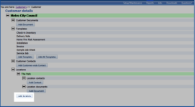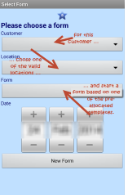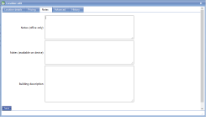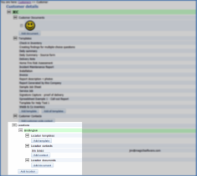|
Attach Locations to a customer in magic5. Straightaway you will be able to see which locations have already been set up for a customer. Right-click to remove or left-click to edit existing details. Multiple locations can be added to a single customer. Once added, amend details by clicking on the location name. Prompts and tabs shown here are representative only and may be different on an individual system |
Location details |
These are general location details | |
| *Location name | Enter a name that clearly defines this location from others in the customer's organisation. | |
| Address | Enter the address of this location, remembering that it may be used in correspondence. | |
| Post code | Enter the customer's post code. | |
| Phone number | Enter the customer's phone number. | |
| Fax number | Enter the customer's fax number. | |
| Sage code |
A unique code for synchronising with a Sage system. If you don't know what this means, then you should leave it blank. |
|
| Site code | A piece of text (usually from a third party system such as Sage) used for reference only. | |
| Region or location group |
A list can be created to hold groups of locations that reflect the organisation of customers. These may be regions (such as South West, North East), counties (Sussex, Norfolk, etc), countries (UK, Ireland, Holland) or any other location grouping required. These groups can be allocated to users so that, for instance, the Regional Manager for your customer can access reports in their regionwithout being associated with every individual location. See Users and Create list for more information. Select the location group from the drop down list to include this location in that group, thereby making it available to any users (customers) associated with the same group. NB in order to appear here, the list must be called Location groups. |
|
Pricing |
These are specialist fields used with pricing matrices. For further information about setting up matrices see Pricing matrices, Measure work matrices and Productivity matrices. | |
| Pricing model for job | select from drop-down list | |
| Productivity matrix | select matrix from list | |
| Multiplier to apply to all items in productivity matrix | enter a number | |
| Pricing matrix | select matrix from list | |
| Multiplier to apply to all items in pricing matrix | enter a number | |
| Measure work matrix | select matrix from list | |
| Multiplier to apply to all items in measure work matrix | enter a number | |
| Use measure work | tick the box to use measure work | |
| List of tasks | select a list name from the drop-down list | |
| Variation list | select a list name from the drop-down list | |
| Day rate list | select a list name from the drop-down list | |
| Working method/uplift list | select a list name from the drop-down list | |
| Sell day rate (do not enter a currency symbol, simply xxx.xx) | enter a figure with 2 decimal places | |
Notes |
Enter text related to this location that will help operatives carry out their work effectively | |
| Notes (office only) |
Free text that will be displayed for administrative users only. The notes can be displayed by adding them to an associated Job definition using a 'Display-only information (not saved)' Job definition item type and, in the 'Format/value of auto-generated item prompt under the Advanced tab', entering For example, “only send engineer with X2 qualification” will remind an administrator that some engineers may be more suitable than others for this customer or location. Office notes can also be displayed on the device in a default value field for an item type on the template, although this is uncommon. |
|
| Notes (available on device) |
Free text that will be displayed for device users only. The notes can be displayed by creating a General output data item type with an entity type corresponding to where the notes are attached (eg customer or location) and, in the 'Additional details to display (advanced)' text box enter: For example, "report to site office" or "send extra copy of report to head office" will remind a user about particular behaviours for this customer, location, etc. Device notes can also be displayed on the device in a default value field for an item type on the template.
|
|
| Building description | Enter text to describe the building when this location is selected on the device | |
Advanced |
Location specific attributes that can be made available to operatives. This enables an operative to, for instance, view a site plan without having to search through multiple sites. Or select a piece of machinery from a list of those known to be on this site. | |
| Project manager | Select from a list of users. This can be used to contact the project manager | |
| List of rooms | Select the name of a list from the drop-down list | |
| List of drawings/plans | Select the name of a list from the drop-down list. These can be used with Drawing locations | |
| List of units | Select the name of a list from the drop-down list. | |
| List containing contracts for this location | Select the name of a list from the drop-down list. | |
History |
Use this tab to maintain the history of a location. This can be done manually or through actions on a template, meaning that installations, servicing, inspections, etc can be recorded with dates. The text held here can be included on forms for this location, informing onsite operatives of previous work. | |
| History | Entered manually or automatically through template or job actions. | |
Add location details |
Use these buttons to add location specific templates, contacts and documents. The questions asked are the same as for the templates, customer-wide contacts and documents above. |








